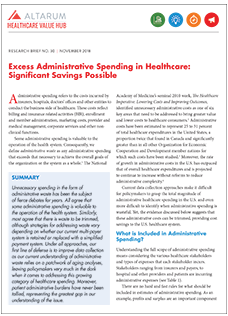Improving Value
Addressing Excess Administrative Costs
Administrative spending refers to the costs incurred by insurers, hospitals, doctors’ offices and other entities to conduct the business side of health care. These costs reflect billing and insurance related activities (BIR), enrollment and member administration, marketing costs, provider and medical management, corporate services and other non-clinical functions. While some administrative spending is necessary to the operation of the health care system, excess administrative spending has significant implications for the U.S. health care system. Furthermore, increased administrative activities and costs are associated with higher physician burnout and increased affordability burdens being placed on consumers.
Our current understanding of administrative spending relies on a patchwork of mostly aging analyses, leaving policymakers very much in the dark when it comes to addressing this growing category of health care spending. Moreover, patient administrative burdens have never been tallied, representing the greatest gap in our understanding of administrative burden. Patients incur administrative costs when they enroll in coverage, receive care and seek reimbursement for expenses.
While hard estimates of administrative waste are hard to come by, comparative data suggests there is significant excess administrative spending. A majority of this excess spending is associated with having a multi-payer financing system which results in a wide variety of rules regarding provider credentialing, quality assurance, billing and payment.
Several approaches have been proposed to curtail excess administrative spending, some feasible within our current multi-payer system and some premised on a health system with reducing and streamlining our payers. Under all approaches, our first line of defense is to improve data collection to establish targets to address waste. Strategies that can be deployed within our current multi-payer system include:
- Simplify health coverage eligibility rules and reducing churn,
- Simplify and standardize claim coding and payment rules,
- Establish uniform, national accreditation and licensing standards, and
- Standardize quality benchmarks
As single-payer proponents point out, a single-payer approach would significantly reduce administrative spending. Consolidating basic insurance functions into a single entity means economies of scale, streamlined billing and sharply reduced burdens of claims processing, and eliminates the need for marketing, advertising and underwriting expenses. Similarly, a universal coverage approach can reduce or eliminate the expenses associated with determining eligibility for coverage, depending how it is enacted.
This Hub Research Brief discusses the significant savings available by optimizing the administrative tasks in our health care system.
- Hub Infographic: What Drives Healthcare Spending?
- Hub Webinar: Single Payer: What Needs to be Included to Bend the Cost Curve? (May 2019).
- Hub Research Brief: Single Payer: Can it Bend the Cost Curve? (April 2019).
- JAMA Network: Administrative Costsand Health Information Technology (August 2018).
- Center for American Progress: Excess Administraive Costs Burden the U.S. Health Care System (April 2019).







